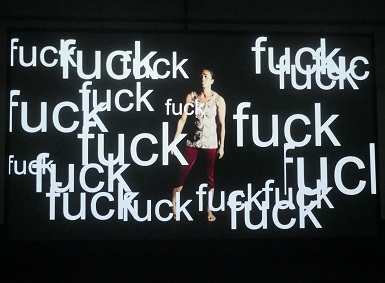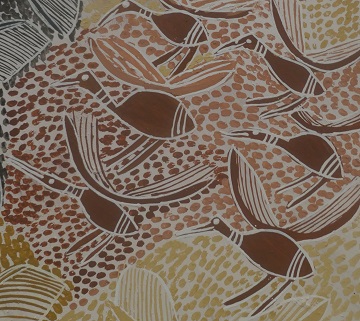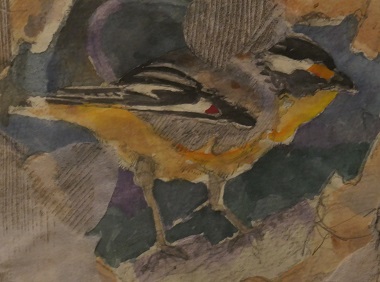THE NATIONAL 2021

Vernon Ah Kee's provocative text over Dalisa Pigram's dance and angry words in 'Gudirr Gudirr'
Posted by Jeremy Eccles | 29.03.21
Dates:
27.03.21
Location: Carriageworks (closing June 20), MCA (closing August 22), AGNSW (closing 5 September)
The third iteration of 'The National' “showcasing the varied and vital work being made by Australian artists” has opened across three venues in Sydney – Carriageworks, the Museum of Contemporary Art and the Art Gallery of NSW. Whether there will be another after the three biennial shows now completed probably depends a bit on how well this one goes down – though it must benefit from its good fortune in avoiding last year and the resulting hunger of viewers for visual stimulation.
I attended the press preview, of course, with a primary concern for the First Nations content and freely admit that I may have missed some of the potency of non-Indigenous contributions. But the big picture that emerged was a) some stand-out Indigenous work which, I note has already taken the headlines in ArtsHub's review; b) a preponderance of women artists – 31 to 15 men, with the MCA's female hierarchy leading the way; and c) artists with an Asian ancestry have a significant role – especially at the Art Gallery, with its specialist Asian curator, Matt Cox at the helm.
But by far my most visceral response was to my discovery of the recent death of Mulkun Wirrpanda at c79. It's been hard to ignore this senior Yolŋu artist in recent years as she held fascinating exhibitions with the English-born John Wolseley in which the two elders examined Arnhemland's nature from their respective viewpoints with great courtesy and intriguing cross-overs. Her interest was in passing on her traditional knowledge of food resources – from both bush and beach – and she apparently insisted that she be fed only on these after a heart-attack earlier this year. Her last project with Wolseley, featuring in 'The National', revolved around the eusocial world of her local magnetic termite mounds in which the hard-working termites willingly shared their home with a variety of other creatures, including meat-ants and the red-browed pardolote bird.
Despite her recent death, Mulkun's daughter and grandson joined John Wolseley in Sydney to pay tribute to both her artistic life and her passion for revitalising, maintaining and sharing Yolŋu cultural knowledge.
What a difference to the other notable Indigenous work. Again a collaboration, between the unlikely pairing the Broome-based dancer/choreographer, Dalisa Pigram and Brisbane's Vernon Ah Kee, often a text-based fomenter, here a film-director. 'Gudirr Gudirr' was a break-through solo dance work by Pigram in 2103. Now she's re-worked it, been filmed in stop-motion, and added angry or bitter words that are amplified by Ah Kee's texts across three massive screens at Carriageworks. There are some unnecessary film additions that lower tension; but the core of Pigram's despair can be summed up in her cry calling for a time “when suicide as a word in Aboriginal languages is over”.
This anguished message surely deserved the dimension and perfect blackness of its screens. But was sheer size always justified elsewhere in the Indigenous realm? I reckon Lorraine Connelly-Northey hits the mark with a huge wall-work lining up hundreds of her small recycled wire-works like musical notation to be sung. And Mimili's Betty Kuntiwa Pumani's five months of effort in encompassing her mother's 850,000 hectare 'Antara' Country across 10 metres of canvas was dauntingly grand at the MCA. But both Betty Muffler's and Maringka Burton's collaboration on sizeable canvases in the AGNSW's arrival hall may have over-stretched the visual possibilities of their story of their lives as ngangkari healers and the flowering of the narcotic pitchuri plant after rain on the land of the Anamari/Caterpillar Tjukurpa.
Downstairs, the great man from Badhu in the Torres Strait, Alick Tipoti matches some wonderful old linocut prints – one 10 metres long again – with new fibreglass dugong and shark 'madhubal' charms designed to draw in the hunter's prey. However, they seemed to me to lack the dramatic appeal of his earlier incised bronze sea creatures – like the ones showing currently at the Maritime Museum in Sydney. However, the opening weekend traditional dances by the Tipoti Family brought the TSI culture briefly alive in Sydney.
Both Tipoti and the Muffler/Maringka team have films about their working lives on show on I-Pads. Above, sadly, Judy Watson's work hanging in the void suffers from the cluttering feel of washing day at the AGNSW.
Finally, films from the Karrabing Film Collective from around Wadeye in the NT, who recently had a showing in New York. Their work pulls the curtain aside on the realities of life in the unnatural communities governments have imposed upon post-tribal people, and is well-worth pausing for in Carriageworks.
Did anyone mention COVID? Oddly not – though Fiona Hall greets us thoughtfully as you enter the Art Gallery with 'EXODUST', reminding us how many floral and faunal lives were lost in the 2019/20 fires. Darren Sylvester requires a similarly detailed investigation of the realities behind his flytraps of colour and light in Carriageworks. And Mehwish Iqbal's 50,000 human cut-outs flowing along her 'Grey Wall' at the MCA puts humanity on a par with the masses of the insect world in a provocative way.
Back to Mulkun Wirrpanda's termite mounds!
URL: https://www.the-national.com.au/
Share this:
»  del.icio.us
»
del.icio.us
»  Digg it
»
Digg it
»  reddit
»
reddit
»  Google
»
Google
»  StumbleUpon
»
StumbleUpon
»  Technorati
»
Technorati
»  Facebook
Facebook
Contact Details

The late Mulkun Wirrpanda's pardalotes from her eusocial bark series examining the harmony of life in an Arnhemland termite mound

Wirrpanda's collaborator, John Wolseley paints his version of the same bird, the red-browed pardolote
Further Research
Artists: Alick Tipoti | Betty Kuntiwa Pumani | Betty Muffler | Judy Watson | Karrabing Film Collective | Lorraine Connelly-Northey | Maringka Burton | Mulkun Wirrpanda | Vernon Ah Kee
News Tags: Art Gallery on NSW | Carriageworks | Dalisa Pigram | Jeremy Eccles | John Wolseley | MCA | pardalotes | The National
News Categories: Australia | Blog | Event | Exhibition | Feature | Festival | Industry | News
Exhibition Archive
- 29.03.21 | THE NATIONAL 2021
- 24.03.21 | All Revealed in Freo
- 22.03.21 | Bla Mela Kantri
- 19.03.21 | Two Big Moves
- 16.03.21 | The Very Late Charlie Flannigan
- 08.03.21 | PAPUNYA ART AT 50
- 19.02.21 | National Endowment for Indigenous Visual Arts
- 11.01.21 | "Lost in Another Person's Culture”
- 04.01.21 | Appreciating Mparntwe
- 09.12.20 | Museological Sydney
- 02.12.20 | Getting Back into the Habit in Sydney
- 25.11.20 | VICTORIA OPENS!
- 17.11.20 | Aboriginal Art Storms Online
- 10.11.20 | 'Nilimurra Dhuwal: Here We Are' by Guynbi Ganambarr
- 06.11.20 | GORDON BENNETT SOLO IN QUEENSLAND
Advertising

